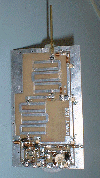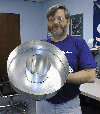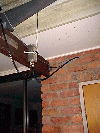| Dr. Dave Clingerman, W6OAL, through his company Olde Antenna Lab, produces a commercial SETI LNBF assembly (integrated Low Noise preamp, Block downconverter and Feedhorn) for Project Argus use. Here on his workbench, the helical feed (left), LNA (right, smaller box) and downconverter (right, larger box) are awaiting installation into the PVC radome (seen at rear center). |
 W6OAL photo |
| Tom Clark's Totally Accurate Clock project is providing SETI League members with a low-cost precision time and frequency standard. The circuit board shown here interfaces via an RS-232 connection to a personal computer's serial port. The metal box seen mounted above the circuit board is a Garmin GPS, with its patch antenna on top. In addition to providing accurate position information and both Greenwich Mean Sidereal Time (GMST) and Local Mean Sidereal Time (LMST) to atomic-clock accuracy, the unit can be used to slave a precision crystal oscillator to 1e-09 (one part in a thousand million) accuracy. |

SETI League |
| Stable, low-cost hydrogen-line weak signal source, with a quarter-wave antenna of brass hobby tubing soldered to the output microstripline. The test signal can be heard in sensitive SETI receivers at a distance of several hundred meters. Construction details appear in the accompanying article. |

SETI League |
| The commercial version of the SETI League weak signal source is sold by noted equipment supplier Down East Microwave, as their Model 1420-WSSK for $60 in kit form. Here is a packaged version, using an enclosure supplied by Down East Microwave. (Note the homebrew querter wave whip antenna at upper right.) A discount is offered to SETI League members in good standing. |

SETI League |
| Executive director Dr. H. Paul Shuch, hard at work in The SETI League's microwave circuit development lab, modifying the above AmpliFilter. |

SETI League |
| Improved SETI feedhorn incorporating a scalar choke ring, fully described in the accompanying article. The placement of the choke ring along the waveguide feedhorn can be varied to optimize performance for maximum gain, or minimum noise temperature, as required by the user. The feed can also be readily optimized for dishes with a wide range of focal length to diameter (F/D) ratios. |

SETI League |
Follow this link to Hydrogen Line Downconverter photos.
Follow this link to Hydrogen Line Receiver Development photos.
Click here for lots more pictures.
email the Webmaster | entire website copyright © The SETI League, Inc. this page last updated 29 November 2003 |
Top of Page |
 Technical Manual
Technical Manual











